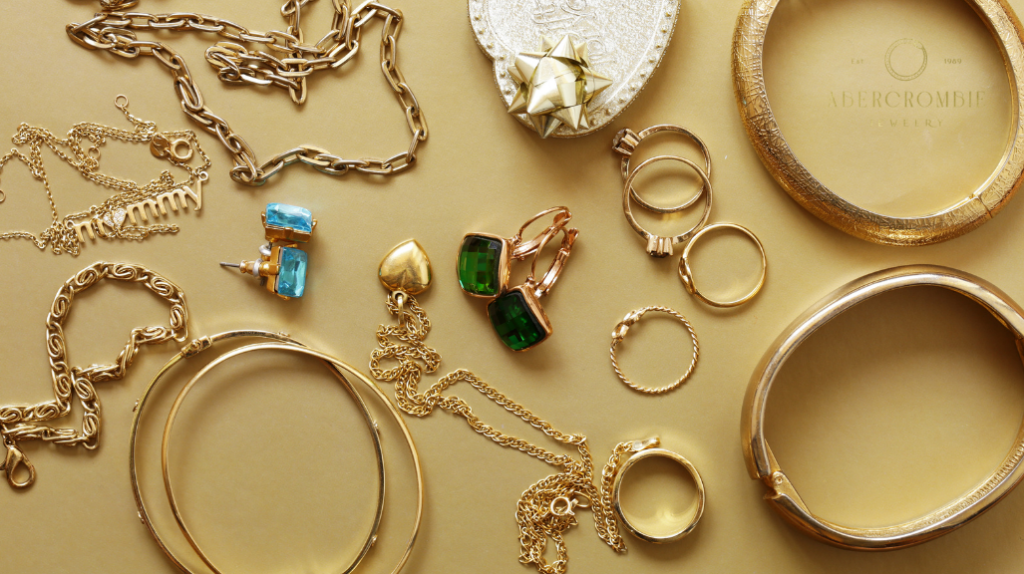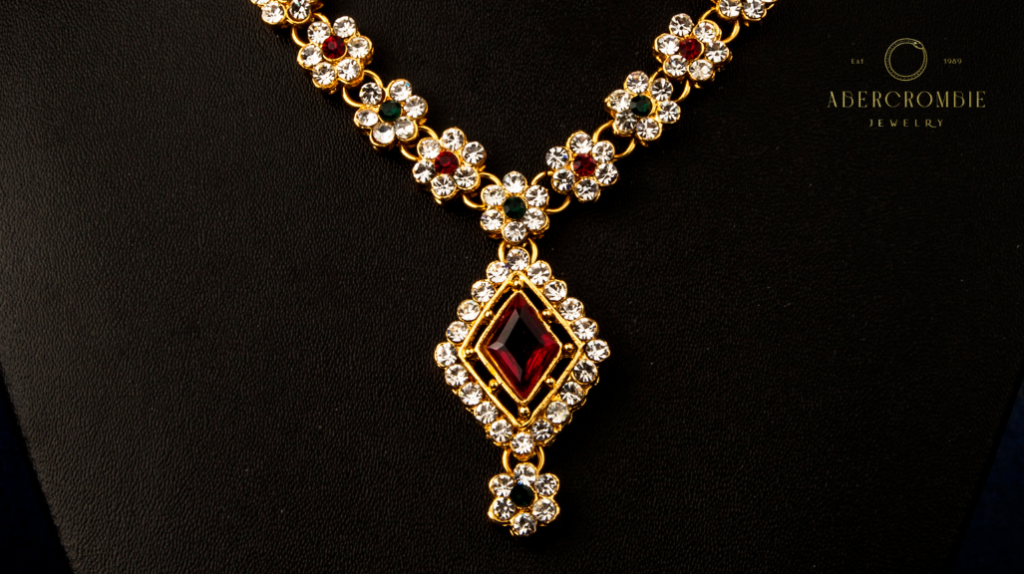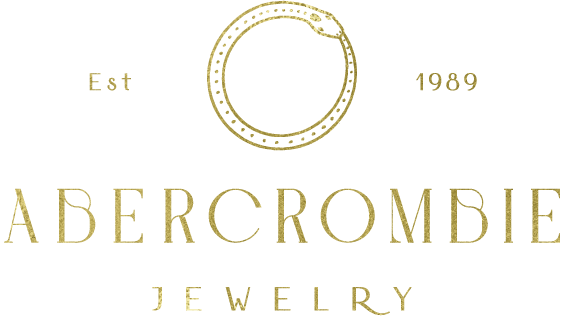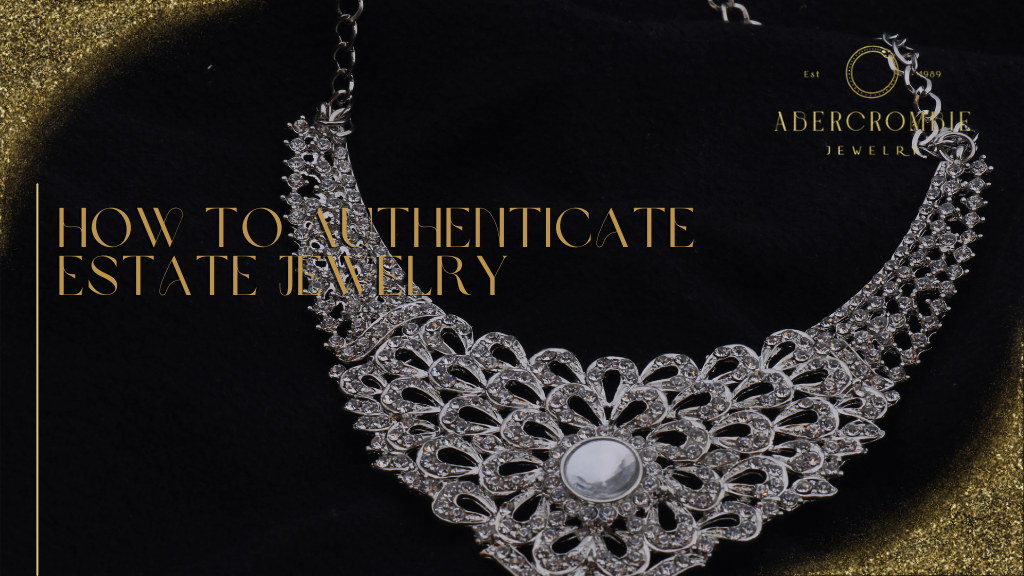Estate jewelry holds timeless charm, value, and history, making each piece unique and highly desirable. However, authenticating estate jewelry can be challenging, especially when identifying age, craftsmanship, and material quality, which are crucial aspects of antique jewelry. Knowing how to authenticate estate jewelry preserves its value and gives buyers and sellers confidence in each piece. For those looking to sell, finding reputable Estate Jewelry Buyers in Austin can ensure you receive a fair offer for your valuable pieces.
Here’s a step-by-step guide from the experts at Abercrombie Jewelry to help you identify the characteristics of genuine estate jewelry.
Key Takeaways:
- Understand the Value of Estate Jewelry: Estate jewelry includes pre-owned pieces valued for their history, quality materials, and craftsmanship. Proper authentication helps preserve their unique charm and financial worth. Evaluating fine jewelry, including estate and vintage pieces, involves assessing factors like rarity, materials, and market trends to determine their true value.
- Identify Hallmarks and Maker’s Marks: Look for stamps that indicate metal purity, country of origin, or designer. These marks help confirm the authenticity and origin of estate jewelry.
- Examine Craftsmanship and Materials: Authentic estate jewelry often features high-quality metals, natural gemstones, and meticulous setting techniques that may not be common in modern pieces.
- Match Design Style to Historical Eras: Each design era has distinct characteristics. Matching your piece’s style to periods like Victorian or Art Deco can help verify its authenticity.
- Check for Signs of Age: Genuine estate pieces usually show subtle signs of wear. Minor scratches or patina indicate authenticity, while overly pristine pieces may be reproductions.
- Consult a Professional Appraiser: For the most reliable authentication, professional appraisals provide expert evaluation, use specialized tools, and offer documentation that enhances value and confidence.
- Avoid Common Authentication Mistakes: Not all authentic pieces will have hallmarks or maker’s marks, so consider provenance, historical style, and expert evaluation to avoid misidentifying estate jewelry.
Why Authentication is Important for Vintage and Antique Jewelry

Authentication is crucial for establishing estate jewelry’s quality, historical value, and authenticity. Ensuring a piece is genuine protects both buyers and sellers from potential counterfeit issues. Also, authenticated estate jewelry can significantly increase in value, especially if linked to a renowned designer, specific historical period, or high-quality gemstones and materials. Awareness of market trends within the jewelry industry is also essential as specific styles and periods gain popularity over time, influencing demand and potential investment decisions.
Steps to Authenticate Estate Jewelry
1. Examine the Hallmarks and Maker’s Marks
Hallmarks and maker’s marks are key identifiers in estate jewelry authentication. These stamps provide information about the metal purity, origin, and sometimes even the jewelry designer. Here’s what to look for:
- Metal Purity Stamps: Authentic estate jewelry typically has stamps indicating the metal’s purity, such as “18K” for gold or “PLAT” for platinum. Older pieces might have hallmarks specific to their country of origin.
- Maker’s Marks: Maker’s marks are unique symbols or initials representing the jewelry maker or brand. For instance, recognized brands like Cartier or Tiffany & Co. have distinct maker’s marks that are widely recognized and signify authenticity and quality.
- Country of Origin Stamps: Countries often have distinct hallmarks (e.g., British or French stamps) that indicate authenticity and origin.
If these marks are missing, worn down, or unclear, consult a professional jeweler, as they may have tools to identify faint or hidden hallmarks.
To learn more about the significance of markings and metals in estate jewelry, check out our guide on What Does 925 Mean on Jewelry.
2. Analyze the Craftsmanship and Precious Metals
Estate jewelry is often valued for its craftsmanship, particularly for pieces made by hand or using intricate techniques that may not be common today. A few things to examine:
- Setting Techniques: Authentic estate pieces often showcase fine detail and quality setting methods, such as prongs, bezels, or pave settings, which securely hold gemstones in place.
- Metal Quality: High-quality estate jewelry is typically made from precious metals like gold, platinum, or sterling silver. Look for weight and quality as indicators, as authentic pieces are usually heavier due to the use of solid metals.
- Gemstone Quality: Genuine estate jewelry features natural gemstones that may show minor imperfections, which are expected in older pieces. Synthetic or imitation stones often indicate a lack of authenticity.
When dealing with high-value items, it’s crucial to authenticate designer jewelry to ensure its legitimacy and value.
For tips on ensuring your jewelry stays in top condition, see our article on How to Clean Tarnished Jewelry

3. Research the Jewelry Style and Era
Each period in jewelry history has distinctive design characteristics, which are useful for dating and authenticating estate jewelry:
- Victorian Era (1837-1901): Pieces often include intricate designs, floral motifs, and sentimental engravings, using metals like gold and silver.
- Art Deco (1920s-1930s): Known for geometric designs, bold colors, and materials such as platinum and diamonds.
- Retro Period (1940s-1950s): Recognized for chunky, colorful pieces and the use of rose gold and yellow gold.
Matching your piece’s design style to its possible era can help verify its authenticity, especially if the design aligns with the materials and craftsmanship of that period. Additionally, the resurgence of vintage styles, such as Art Deco in the 1990s, highlights jewelry trends’ eclectic and personal nature across different decades.
4. Look for Signs of Age and Wear
Genuine estate jewelry will often show signs of age or wear, which can validate its authenticity. While well-maintained pieces may appear newer, most estate jewelry shows minor scratches or patina, particularly on metals and stone settings. Be cautious if a piece claims to be decades old but appears flawless; it may be a reproduction. Identifying well-known vintage pieces from reputable makers is crucial, as these often command higher prices due to their craftsmanship and historical significance.
5. Consult with a Professional Jeweler or Appraiser
While these steps can guide your initial authentication, nothing replaces a professional evaluation. Like those at Abercrombie Jewelry, Jewelry experts can provide thorough appraisals, using specialized tools and expertise to confirm a piece’s age, quality, and origin. Additionally, antique dealers can offer valuable insights and appraisals due to their specialized knowledge and connections to buyers interested in vintage and antique pieces.
- Gemological Testing: Experts may use gemological tools to examine gemstones and metals closely, verifying the piece’s authenticity and identifying any synthetic or imitation elements.
- Market Knowledge: Professionals stay updated on market trends and hallmarks, which helps identify obscure marks, styles, and historical details unique to each piece.
A certified appraiser can also provide documentation of authenticity, which can increase the jewelry’s resale value and serve as proof of its origin. Learn about Estate Jewelry Appraisal to understand the steps in determining your piece’s value.
Common Mistakes to Avoid When Ensuring Jewelry Authenticity

- Assuming No Hallmark Means, It’s Fake: Some antique or handmade pieces may lack a hallmark, particularly if they’re older. This doesn’t automatically mean they’re inauthentic, but having these pieces professionally appraised is wise.
- Ignoring Provenance: Provenance refers to a piece’s history or previous ownership. Jewelry with well-documented provenance can add significant value, primarily if it is owned by someone notable.
- Overlooking Reproductions: Many reproductions mimic historical styles. If you’re unsure, consult a jeweler to confirm that your piece isn’t a replica but an authentic piece from the original era.
- Neglecting Costume Jewelry: Evaluating various types of jewelry, including costume jewelry, is crucial. Factors such as rarity, materials, and market trends significantly determine the value of different jewelry pieces, including inherited ones.
Why Choose a Professional Like Abercrombie Jewelry for Authentication
Authenticating estate jewelry requires knowledge, tools, and experience. At Abercrombie Jewelry, our team has years of expertise in identifying, evaluating, and buying estate jewelry. We provide professional, detailed appraisals to confirm the authenticity and value of each piece, ensuring that sellers receive fair offers. Whether you want to authenticate a family heirloom or verify a recent purchase, Abercrombie Jewelry offers trusted insights and professional evaluations.
Authenticating estate jewelry is vital for preserving its value and confirming its historical authenticity. By examining hallmarks, craftsmanship, materials, and style, you can gain insights into the piece’s origin and value. However, a professional evaluation remains the most reliable way to authenticate estate jewelry and protect its worth. Staying updated on trends in the jewelry market can also significantly impact the value of different jewelry styles and designs.
Ready to Authenticate Your Estate Jewelry?
If you want to authenticate or sell estate jewelry, contact Abercrombie Jewelry today for a professional appraisal. Our expert team can help you determine the value and authenticity of your piece, providing the insight you need for a confident transaction. A vintage engagement ring, particularly one passed down through generations, can carry significant sentimental and historical value, making it priceless to a family. Schedule your consultation today!

